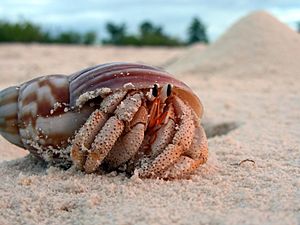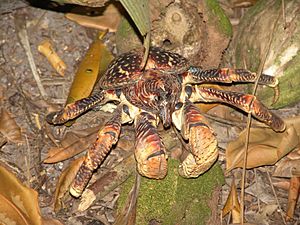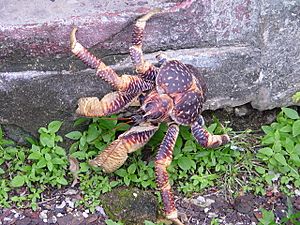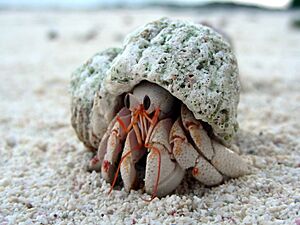Coenobitidae facts for kids
Quick facts for kids Coenobitidae |
|
|---|---|
 |
|
| A Coenobita perlatus | |
 |
|
| The amazing Coconut crab, Birgus latro | |
| Scientific classification |
|
| Kingdom: | Animalia |
| Phylum: | Arthropoda |
| Subphylum: | Crustacea |
| Class: | Malacostraca |
| Order: | Decapoda |
| Superfamily: | Paguroidea |
| Family: | Coenobitidae Dana, 1851 |
| Genera | |
|
|
The Coenobitidae are a family of amazing land-living hermit crabs. Unlike most crabs that stay in the ocean, these crabs spend their adult lives on land! You can find them in warm, tropical coastal areas all over the world. But even though they live on land, they still need to visit the ocean to have their babies.
Contents
Land Hermit Crabs: The Coenobitidae
These special hermit crabs are known for living on land as adults. They are found in tropical places near the coast. Even though they are land animals, they must go back to the ocean to lay their eggs and for their young to grow.
From Ocean to Land: A Crab's Journey
When female Coenobitidae are ready to have babies, they return to the sea. Their eggs hatch into tiny larvae that float in the ocean. These larvae are called "zoeal stages" and later become "megalopae." This is similar to how many ocean-dwelling hermit crabs grow.
Once the megalopae are big enough, they find and move into empty snail shells. These shells become their homes and protect their soft bodies. After finding a shell, they leave the ocean and move onto land. This is when they become young crabs.
Types of Land Hermit Crabs
There are 17 known species in the Coenobitidae family. These species are divided into two main groups, called genera:
- Coenobita: This group includes 16 different species of land hermit crabs. They are often kept as pets and are known for carrying snail shells on their backs.
- Birgus: This group has only one species, the famous Coconut crab (Birgus latro). It is the largest land crab in the world! Unlike other hermit crabs, adult coconut crabs do not carry a shell. Instead, their bodies become hard enough to protect themselves.

See also
 In Spanish: Coenobitidae para niños
In Spanish: Coenobitidae para niños


